List
| Genus | Authors | Year | Status | Age | Location | Notes | Images |
|---|---|---|---|---|---|---|---|
| Abavornis [5] | Panteleyev | 1998 | Valid | Late Cretaceous | Uzbekistan | ||
| Aberratiodontus [6] | Gong et al. | 2004 | Junior synonym | Early Cretaceous | China | Junior synonym of Yanornis. | |
| Abitusavis [7] | Wang et al. | 2020 | Valid | Early Cretaceous | China | ||
| Alamitornis [8] | Agonlin & Martinelli | 2009 | Valid | Late Cretaceous | Argentina | ||
| Alcmonavis [9] | Rauhut et al. | 2019 | Valid | Late Jurassic | Germany |  | |
| Alethoalaornis | Li et al. | 2007 | Valid | Early Cretaceous | China | ||
| Alexornis [10] | Brodkorb | 1976 | Valid | Late Cretaceous | Mexico | ||
| Ambiortus | Kurochkin | 1982 | Valid | Early Cretaceous | Mongolia | ||
| Ambopteryx [11] | Wang et al. | 2019 | Valid | Late Jurassic | China | Considered a non-avialan theropod by some researchers. |  |
| Anatalavis | Olson & Parris | 1987 | Valid | Late Cretaceous | United States England | The type species is known from the Late Cretaceous–Paleocene border, while a referred species is from the Eocene. | |
| Anchiornis [12] | Xu et al. | 2009 | Valid | Late Jurassic | China | Considered a non-avialan theropod by some researchers. |  |
| Angelinornis | Kashin | 1972 | Junior synonym | Late Cretaceous | United States | Junior synonym of Ichthyornis. | |
| Antarcticavis [13] | Cordes-Person et al. | 2020 | Valid | Late Cretaceous | Antarctica | ||
| Apatornis | Marsh | 1873 | Valid | Late Cretaceous | United States |  | |
| Apsaravis [14] | Norell & Clarke | 2001 | Valid | Late Cretaceous | Mongolia | ||
| Archaeopteryx [15] | Meyer | 1861 | Valid | Late Jurassic | Germany | Considered a non-avialan theropod by some researchers. | 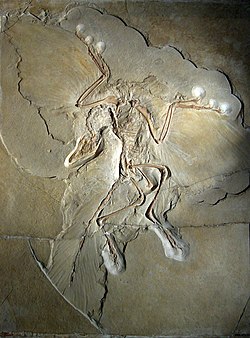 |
| Archaeorhynchus [16] | Zhou & Zhang | 2006 | Valid | Early Cretaceous | China |  | |
| Archaeornis | Petronievics | 1917 | Junior synonym | Late Jurassic | Germany | Junior synonym of Archaeopteryx. | |
| Archaeornithura [17] | Wang et al. | 2015 | Valid | Early Cretaceous | China |  | |
| Archaeovolans | Czerkas & Xu | 2002 | Junior synonym | Early Cretaceous | China | Junior synonym of Yanornis. | |
| Asiahesperornis | Nesov & Prizemlin | 1991 | Valid | Late Cretaceous | Kazakhstan | ||
| Asteriornis [18] | Field et al. | 2020 | Valid | Late Cretaceous | Belgium |  | |
| Aurornis [19] | Godefroit et al. | 2013 | Valid | Late Jurassic | China | Considered a non-avialan theropod by some researchers. |  |
| Austinornis [20] | Clarke | 2004 | Valid | Late Cretaceous | United States | ||
| Avimaia [21] | Bailleul et al. | 2019 | Valid | Early Cretaceous | China |  | |
| Avisaurus [22] | Brett-Surman & Paul | 1985 | Valid | Late Cretaceous | United States |  | |
| Balaur [23] | Csiki et al. | 2010 | Valid | Late Cretaceous | Romania | Originally (and sometimes still) thought to be a non-avialan theropod. |  |
| Baminornis [24] | Chen et al. | 2025 | Valid | Early Cretaceous | China | ||
| Baptornis | Marsh | 1877 | Valid | Late Cretaceous | United States |  | |
| Bauxitornis [25] | Dyke & Ősi | 2010 | Valid | Late Cretaceous | Hungary |  | |
| Beiguornis [26] | Wang et al. | 2022 | Valid | Early Cretaceous | China | ||
| Bellulia | Wang et al. | 2016a | Preoccupied | N/A | N/A | Name preoccupied by the moth Bellulia Fibiger 2008 and replaced by Bellulornis. | |
| Bellulornis | Wang et al. | 2016b | Valid | Early Cretaceous | China | ||
| Bohaiornis [27] | Hu et al. | 2011 | Valid | Early Cretaceous | China |  | |
| Boluochia [28] | Zhou | 1995 | Valid | Early Cretaceous | China | ||
| Bradycneme [29] | Harrison & Walker | 1975 | Misidentification | N/A | N/A | Originally described as a bird; more likely a non-avialan theropod. | |
| Brevidentavis [30] | O'Connor et al. | 2021 | Valid | Early Cretaceous | China | ||
| Brevirostruavis [31] | Li et al. | 2021 | Valid | Early Cretaceous | China | ||
| Brodavis [32] | Martin et al. | 2012 | Valid | Late Cretaceous | United States Mongolia | ||
| Caihong [33] | Hu et al. | 2018 | Valid | Late Jurassic | China | Considered to be a non-avialan theropod by some researchers. |  |
| Camptodontornis [34] | Demirjian | 2019 | Valid | Early Cretaceous | China | ||
| Camptodontus [35] | Li et al. | 2010 | Preoccupied | N/A | N/A | Name preoccupied by the beetle Camptodontus Dejean, 1826 and replaced by Camptodontornis. | |
| Canadaga [36] | Hou | 1999 | Valid | Late Cretaceous | Canada | ||
| Castignovolucris [37] | Buffetaut et al. | 2023 | Valid | Late Cretaceous | France | ||
| Catenoleimus [5] | Panteleyev | 1998 | Valid | Late Cretaceous | Uzbekistan | ||
| Cathayornis | Zhou et al. | 1992 | Valid | Early Cretaceous | China |  | |
| Ceramornis [38] | Brodkorb | 1963 | Valid | Late Cretaceous | United States | ||
| Cerebavis [39] | Kurochkin et al. | 2006 | Valid | Late Cretaceous | Russia | ||
| Changchengornis [40] | Ji et al. | 1999 | Valid | Early Cretaceous | China |  | |
| Changmaornis [41] | Wang et al. | 2013 | Valid | Early Cretaceous | China | 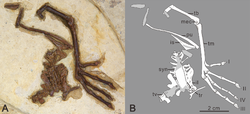 | |
| Changzuiornis [42] | Huang et al. | 2016 | Disputed | Early Cretaceous | China | Possibly synonymous with Juehuaornis. | |
| Chaoyangia | Hou & Zhang | 1993 | Valid | Early Cretaceous | China | ||
| Chiappeavis [43] | O'Connor et al. | 2016 | Valid | Early Cretaceous | China | ||
| Chongmingia [44] | Wang et al. | 2016 | Valid | Early Cretaceous | China | ||
| Chupkaornis [45] | Tanaka et al. | 2017 | Valid | Late Cretaceous | Japan | ||
| Cimoliornis | Owen | 1846 | Misidentification | N/A | N/A | Originally described as a bird; actually a pterosaur. | |
| Cimolopteryx | Marsh | 1892 | Valid | Late Cretaceous | United States | May be Paleocene. |  |
| Colonosaurus [46] | Marsh | 1872 | Junior synonym | Late Cretaceous | United States | Junior synonym of Ichthyornis. | |
| Concornis [47] | Sanz & Buscalioni | 1992 | Valid | Early Cretaceous | Spain |  | |
| Confuciusornis [48] | Hou et al. | 1995 | Valid | Early Cretaceous | China |  | |
| Coniornis | Marsh | 1893 | Junior synonym | Late Cretaceous | United States | Junior synonym of Hesperornis. | |
| Cosesaurus [49] | Ellenberger & de Villalta | 1974 | Misidentification | N/A | N/A | Sometimes proposed to be a bird ancestor; actually a tanystropheid. | |
| Cratoavis [50] | Carvalho et al. | 2015 | Valid | Early Cretaceous | Brazil | ||
| Cratonavis [51] | Li et al. | 2023 | Valid | Early Cretaceous | China | ||
| Cretaaviculus | Bazhanov | 1969 | Valid | Late Cretaceous | Kazakhstan | ||
| Cretornis [52] | Fritsch | 1880 | Misidentification | N/A | N/A | Originally described as a bird; actually a pterosaur. | |
| Cruralispennia [53] | Wang et al. | 2017 | Valid | Early Cretaceous | China |  | |
| Cuspirostrisornis [54] | Hou | 1997 | Valid | Early Cretaceous | China | ||
| Dalianraptor | Gao & Liu | 2005 | Disputed | N/A | N/A | Likely a chimaera consisting of a Jeholornis and another theropod. | |
| Dalingheornis [55] | Zhang et al. | 2006 | Valid | Early Cretaceous | China | ||
| Dapingfangornis [56] | Li et al. | 2006 | Valid | Early Cretaceous | China | ||
| Didactylornis [57] | Yuan | 2008 | Junior synonym | Early Cretaceous | China | Junior synonym of Sapeornis. | |
| Dingavis [58] | O'Connor et al. | 2016 | Disputed | Early Cretaceous | China | Possibly synonymous with Changzuiornis and/or Juehuaornis. | |
| Dunhuangia [59] | Wang et al. | 2015 | Valid | Early Cretaceous | China | ||
| Elbretornis [60] | Walker & Dyke | 2009 | Valid | Late Cretaceous | Argentina | Possibly synonymous with Lectavis, Soroavisaurus and/or Yungavolucris. | |
| Elektorornis [61] | Xing et al. | 2019 | Valid | Early Cretaceous | Myanmar | ||
| Elopteryx [62] | Andrews | 1913 | Misidentification | N/A | N/A | Originally described as a bird; more likely to be a non-avialan theropod. |  |
| Elsornis [63] | Chiappe et al. | 2007 | Valid | Late Cretaceous | Mongolia | ||
| Enaliornis | Seeley | 1876 | Valid | Late Cretaceous | England | ||
| Enantiophoenix [64] | Cau & Arduini | 2008 | Valid | Late Cretaceous | Lebanon | ||
| Enantiornis [65] | Walker | 1981 | Valid | Late Cretaceous | Argentina |  | |
| Eoalulavis [66] | Sanz et al. | 1996 | Valid | Early Cretaceous | Spain | ||
| Eocathayornis [67] | Zhou | 2002 | Valid | Early Cretaceous | China | ||
| Eoconfuciusornis [68] | Zhang et al. | 2008 | Valid | Early Cretaceous | China | 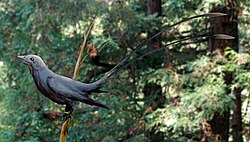 | |
| Eoenantiornis [69] | Hou et al. | 1999 | Valid | Early Cretaceous | China |  | |
| Eogranivora [70] | Zheng et al. | 2018 | Valid | Early Cretaceous | China |  | |
| Eopengornis | Wang et al. | 2014 | Valid | Early Cretaceous | China | ||
| Eosinopteryx [71] | Godefroit et al. | 2013 | Valid | Late Jurassic | China | Considered a non-avialan theropod by some researchers. | 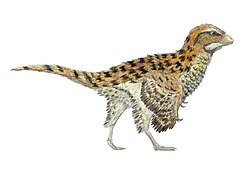 |
| Epidendrosaurus [72] | Zhang et al. | 2002 | Junior synonym | Late Jurassic | China | Possible synonym of Scansoriopteryx. | |
| Epidexipteryx [73] | Zhang et al. | 2008 | Valid | Late Jurassic | China | Considered a non-avialan theropod by some researchers. |  |
| Eurolimnornis [74] | Kessler & Jurcsák | 1986 | Misidentification | N/A | N/A | Originally described as a bird; reinterpreted as a pterodactyloid pterosaur. | |
| Evgenavis [75] | O'Connor et al. | 2014 | Valid | Early Cretaceous | Russia | ||
| Explorornis [5] | Panteleyev | 1998 | Valid | Late Cretaceous | Uzbekistan | ||
| Falcatakely [76] | O'Connor et al. | 2020 | Valid | Late Cretaceous | Madagascar | ||
| Feitianius [77] | O'Connor et al. | 2015 | Valid | Early Cretaceous | China | ||
| Flexomornis [78] | Tykoski & Fiorillo | 2010 | Valid | Late Cretaceous | United States | ||
| Fortipesavis [79] | Clark & O'Connor | 2021 | Valid | Early Cretaceous | Myanmar | ||
| Fortunguavis [80] | Wang et al. | 2014 | Valid | Early Cretaceous | China | ||
| Fujianvenator [81] | Xu et al. | 2023 | Valid | Late Jurassic | China | Found within the family Anchiornithidae, which may represent non-avialan dinosaurs | |
| Fukuipteryx [82] | Imai et al. | 2019 | Valid | Early Cretaceous | Japan |  | |
| Fumicollis [83] | Bell & Chiappe | 2015 | Valid | Late Cretaceous | United States | ||
| Gallornis | Lambrecht | 1931 | Valid | Early Cretaceous | France | ||
| Gansus [84] | Hou & Liu | 1984 | Valid | Early Cretaceous | China |  | |
| Gargantuavis [85] | Buffetaut & Le Loeuff | 1998 | Valid | Late Cretaceous | France Spain Romania |  | |
| Gettyia [86] | Atterholt et al. | 2018 | Valid | Late Cretaceous | United States | ||
| Gobipipus [87] | Kurochkin & Chatterjee | 2013 | Valid | Early Cretaceous | Mongolia | Very similar to embryonic Gobipteryx. | |
| Gobipteryx [88] | Elżanowski | 1994 | Valid | Late Cretaceous | Mongolia | ||
| Grabauornis [89] | Dalsätt et al. | 2014 | Valid | Early Cretaceous | China | ||
| Gracilornis [90] | Li & Hou | 2011 | Valid | Early Cretaceous | China | ||
| Graculavus | Marsh | 1872 | Valid | Late Cretaceous | United States | May be Paleocene. | |
| Gretcheniao | Chiappe et al. | 2019 | Valid | Early Cretaceous | China | ||
| Griphornis | Woodward | 1862 | Junior synonym | Late Jurassic | Germany | Name officially rejected in favor of Archaeopteryx. | |
| Griphosaurus | Wagner | 1862 | Junior synonym | Late Jurassic | Germany | Name officially rejected in favor of Archaeopteryx. | |
| Guildavis [20] | Clarke | 2004 | Valid | Late Cretaceous | United States | ||
| Gurilynia [91] | Kurochkin | 1999 | Valid | Late Cretaceous | Mongolia | ||
| Halimornis [92] | Chiappe | 2002 | Valid | Late Cretaceous | United States | ||
| Hargeria | Lucas | 1903 | Junior synonym | Late Cretaceous | United States | Junior synonym of Hesperornis. | |
| "Hebeiornis" [93] | Xu et al. | 1999 | Nomen nudum | N/A | N/A | Synonym of Vescornis due to being based on the same holotype. However, despite predating the description of Vescornis by five years, its description is so poor that it is regarded as a nomen nudum and a synonym. | |
| Heptasteornis [29] | Harrison & Walker | 1975 | Misidentification | N/A | N/A | Originally described as a bird; more likely a non-avialan theropod. | |
| Hesperornis | Marsh | 1872 | Valid | Late Cretaceous | United States Canada Russia |  | |
| Holbotia [94] | Zelenkov & Averianov | 2015 | Valid | Early Cretaceous | Mongolia | ||
| Hollanda [95] | Bell et al. | 2010 | Valid | Late Cretaceous | Mongolia |  | |
| Hongshanornis [96] | Zhou & Zhang | 2005 | Valid | Early Cretaceous | China |  | |
| Horezmavis | Nessov & Borkin | 1983 | Valid | Late Cretaceous | Uzbekistan | ||
| Houornis [97] | Wang & Liu | 2015 | Valid | Early Cretaceous | China | ||
| Huoshanornis [98] | Wang et al. | 2010 | Valid | Early Cretaceous | China | ||
| Iaceornis [20] | Clarke | 2004 | Valid | Late Cretaceous | United States | ||
| Iberomesornis [99] | Sanz & Bonaparte | 1992 | Valid | Early Cretaceous | Spain |  | |
| Ichthyornis | Marsh | 1873 | Valid | Late Cretaceous | United States |  | |
| Ilerdopteryx | Lacasa-Ruiz | 1985 | Valid | Early Cretaceous | Spain | ||
| Imparavis [100] | Wang et al. | 2024 | Valid | Early Cretaceous | China | ||
| Incolornis [5] | Panteleyev | 1998 | Valid | Late Cretaceous | Uzbekistan | ||
| Intiornis [101] | Novas et al. | 2010 | Valid | Late Cretaceous | Argentina |  | |
| Iteravis | Zhou et al. | 2014 | Valid | Early Cretaceous | China | ||
| Janavis [102] | Benito et al. | 2022 | Valid | Late Cretaceous | Belgium | ||
| Jeholornis [103] | Zhou et al. | 2002 | Valid | Early Cretaceous | China |  | |
| Jianchangornis [104] | Zhou et al. | 2009 | Valid | Early Cretaceous | China | ||
| Jibeinia [54] | Hou | 1997 | Valid | Early Cretaceous | China | ||
| Jinfengopteryx [105] | Ji et al. | 2005 | Misidentification | N/A | N/A | Originally described as a bird; actually a non-avian dinosaur. | |
| Jinguofortis [106] | Wang et al. | 2018 | Valid | Early Cretaceous | China |  | |
| Jinzhouornis | Hou et al. | 2002 | Junior synonym | Early Cretaceous | China | Junior synonym of Confuciusornis. | |
| Jiuquanornis [41] | Wang et al. | 2013 | Valid | Early Cretaceous | China |  | |
| Jixiangornis [107] | Ji et al. | 2002 | Valid | Early Cretaceous | China |  | |
| Judinornis | Nessov & Borkin | 1983 | Valid | Late Cretaceous | Mongolia | ||
| Juehuaornis [108] | Wang et al. | 2015 | Valid | Early Cretaceous | China | ||
| Junornis [109] | Liu et al. | 2017 | Valid | Early Cretaceous | China |  | |
| Jurapteryx | Howgate | 1984 | Junior synonym | Late Jurassic | Germany | Junior synonym of Archaeopteryx. | |
| Kaririavis [110] | Carvalho et al. | 2021 | Valid | Early Cretaceous | Brazil | ||
| Khinganornis [111] | Wang et al. | 2020 | Valid | Early Cretaceous | China | ||
| Kizylkumavis [112] | Nessov | 1984 | Valid | Late Cretaceous | Uzbekistan | ||
| Kompsornis [113] | Wang et al. | 2020 | Valid | Early Cretaceous | China | ||
| Kookne | Novas et al. | 2019 | Valid | Late Cretaceous | Argentina | ||
| Kunpengornis [114] | Huang et al. | 2025 | Valid | Early Cretaceous | China | ||
| Kuszholia [115] | Nesov | 1992 | Valid | Late Cretaceous | Uzbekistan | ||
| Lamarqueavis [116] | Agnolin | 2010 | Valid | Late Cretaceous | Argentina United States Canada | ||
| Laopteryx [117] | Marsh | 1881 | Misidentification | N/A | N/A | Originally described as a bird; actually a pterosaur. | |
| Laornis [118] | Marsh | 1870 | Valid | Late Cretaceous | United States | May be Paleocene. | |
| Largirostrornis [54] | Hou | 1997 | Disputed | Early Cretaceous | China | Possible synonym of Cathayornis. | |
| Lectavis [119] | Chiappe | 1993 | Valid | Late Cretaceous | Argentina | ||
| Lenesornis [120] | Kurochkin | 1996 | Valid | Late Cretaceous | Uzbekistan | ||
| Lestornis [121] | Marsh | 1876 | Junior synonym | Late Cretaceous | United States | Junior synonym of Hesperornis. | |
| Liaoningornis [122] | Hou | 1996 | Valid | Early Cretaceous | China | ||
| Liaoxiornis [123] | Hou & Chen | 1999 | Valid | Early Cretaceous | China |  | |
| Limenavis [124] | Clarke & Chiappe | 2001 | Valid | Late Cretaceous | Argentina | ||
| Limnornis [125] | Kessler & Jurcsak | 1984 | Misidentification | N/A | N/A | Name preoccupied by the ovenbird Limnornis Gould 1839 and replaced by Palaeocursornis. Originally described as a bird; actually a pterosaur. | |
| Lingyuanornis [126] | Ji & Ji | 1999 | Junior synonym | N/A | N/A | Junior synonym of Liaoxiornis as it is based on the same holotype. | |
| Linyiornis [127] | Wang et al. | 2016 | Valid | Early Cretaceous | China | ||
| Lisboasaurus [128] | Seiffert | 1970 | Misidentification | N/A | N/A | Sometimes proposed to be a bird; actually a crocodilian. | |
| Lonchodytes [38] | Brodkorb | 1963 | Valid | Late Cretaceous | United States | May be Paleocene. | |
| Longchengornis [54] | Hou | 1997 | Disputed | Early Cretaceous | China | Possible synonym of Cathayornis. | |
| Longicrusavis [129] | O'Connor et al. | 2010 | Valid | Early Cretaceous | China | ||
| Longipteryx [130] | Zhang et al. | 2001 | Valid | Early Cretaceous | China |  | |
| Longirostravis [131] | Hou et al. | 2004 | Valid | Early Cretaceous | China |  | |
| Longisquama [132] | Sharov | 1970 | Misidentification | N/A | N/A | Sometimes proposed to be a bird ancestor; actually an indeterminate reptile. | |
| Longusunguis [133] | Wang et al. | 2014 | Valid | Early Cretaceous | China |  | |
| Maaqwi [134] | McLachlan et al. | 2017 | Valid | Late Cretaceous | Canada | ||
| Magnusavis [135] | Clark et al. | 2024 | Valid | Late Cretaceous | United States | ||
| Martinavis [136] | Walker et al. | 2007 | Valid | Late Cretaceous | France Argentina | ||
| Meemannavis [30] | O'Connor et al. | 2021 | Valid | Early Cretaceous | China | ||
| Megalancosaurus [137] | Calzavara et al. | 1980 | Misidentification | N/A | N/A | Sometimes proposed to be a bird ancestor, but actually a drepanosaurid. | |
| Mengciusornis [138] | Wang et al. | 2019 | Valid | Early Cretaceous | China | ||
| Microenantiornis | Wei & Li | 2017 | Valid | Early Cretaceous | China | ||
| Mirarce [86] | Atterholt et al. | 2018 | Valid | Late Cretaceous | United States |  | |
| Mirusavis [139] | Wang et al. | 2020 | Valid | Early Cretaceous | China | ||
| Monoenantiornis [140] | Hu & O'Connor | 2016 | Valid | Early Cretaceous | China | ||
| Musivavis [141] | Wang et al. | 2022 | Valid | Early Cretaceous | China | ||
| Mystiornis [142] | Kurochkin et al. | 2011 | Valid | Early Cretaceous | Russia | ||
| Nanantius [143] | Molnar | 1986 | Valid | Early Cretaceous | Australia | ||
| Navaornis [144] | Chiappe et al. | 2024 | Valid | Late Cretaceous | Brazil | ||
| Neimengornis [145] | Wang et al. | 2021 | Valid | Early Cretaceous | China | ||
| Neobohaiornis [146] | Shen et al. | 2024 | Valid | Early Cretaceous | China | ||
| Neogaeornis [147] | Lambrecht | 1929 | Valid | Late Cretaceous | Chile | ||
| Neuquenornis [148] | Chiappe & Calvo | 1994 | Valid | Late Cretaceous | Argentina | ||
| Noguerornis [149] | Lacasa-Ruiz | 1989 | Valid | Early Cretaceous | Spain | ||
| Novacaesareala | Parris & Hope | 2002 | Valid | Late Cretaceous | United States | May be Paleocene. | |
| Novavis [150] | O'Connor et al. | 2025 | In press | Early Cretaceous | China | ||
| Oculudentavis [151] | Xing et al. | 2020 | Misidentification | N/A | N/A | Originally described as a bird; reinterpreted as an indeterminate lizard. | |
| Omnivoropteryx [152] | Czerkas & Ji | 2002 | Valid | Early Cretaceous | China | ||
| Orienantius | Liu et al. | 2019 | Valid | Early Cretaceous | China | ||
| Ostromia [153] | Foth & Rauhut | 2017 | Valid | Late Jurassic | Germany | Considered a non-avialan theropod by some researchers. |  |
| Otogornis | Hou | 1994 | Valid | Early Cretaceous | China | ||
| Palaeocursornis [74] | Kessler & Jurcsak | 1986 | Misidentification | N/A | N/A | Originally described as a bird; actually a pterosaur. | |
| Palaeonornis | Emmons | 1857 | Misidentification | N/A | N/A | Originally described as a bird; actually a junior synonym of the phytosaur Rutiodon . [4] | |
| Palaeopteryx | Jensen | 1981 | Misidentification | N/A | N/A | Originally described as a bird; more likely a non-avian theropod. | |
| Palaeornis | Mantell | 1844 | Misidentification | N/A | N/A | Name preoccupied by the parrot Palaeornis Vigors 1825. Originally described as a bird; actually a pterosaur. | |
| Palaeotringa | Marsh | 1870 | Valid | Late Cretaceous | United States | May be Paleocene. | |
| Palintropus [154] | Brodkorb | 1970 | Valid | Late Cretaceous | United States Canada | ||
| Parabohaiornis [133] | Wang et al. | 2014 | Valid | Early Cretaceous | China | ||
| Parahesperornis [155] | Martin | 1984 | Valid | Late Cretaceous | United States |  | |
| Parahongshanornis [156] | Li et al. | 2011 | Valid | Early Cretaceous | China | ||
| Parapengornis [157] | Hu et al. | 2015 | Valid | Early Cretaceous | China |  | |
| Paraprotopteryx [158] | Zheng et al. | 2007 | Valid | Early Cretaceous | China | ||
| Parascaniornis | Lambrecht | 1933 | Junior synonym | Late Cretaceous | Sweden | Junior synonym of Baptornis. | |
| Parvavis [159] | Wang et al. | 2014 | Valid | Late Cretaceous | China |  | |
| Pasquiaornis [160] | Tokaryk et al. | 1997 | Valid | Late Cretaceous | Canada | ||
| Patagopteryx [161] | Alvarenga & Bonaparte | 1992 | Valid | Late Cretaceous | Argentina | 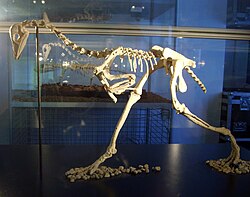 | |
| Pedopenna [162] | Xu & Zhang | 2005 | Valid | Late Jurassic | China | Considered a non-avialan theropod by some researchers. | |
| Pelagornis | Seeley | 1866 | Preoccupied | N/A | N/A | Named preoccupied by the Miocene bird Pelagornis Lartet 1857 and replaced by Enaliornis. | |
| Pengornis [163] | Zhou et al. | 2008 | Valid | Early Cretaceous | China | ||
| Piksi [164] | Varricchio | 2002 | Misidentification | N/A | N/A | Originally described as a bird; reinterpreted as a pterodactyloid pterosaur. | |
| Piscivoravis [165] | Zhou et al. | 2013 | Valid | Early Cretaceous | China |  | |
| Piscivorenantiornis [166] | Wang & Zhou | 2017 | Valid | Early Cretaceous | China | ||
| Platanavis [115] | Nesov | 1992 | Valid | Late Cretaceous | Uzbekistan | ||
| Plegadornis | Wetmore | 1962 | Preoccupied | N/A | N/A | Name preoccupied by the modern bird Plegadornis Brehm 1855; junior synonym of Ichthyornis. | |
| Polarornis [167] | Chatterjee | 2002 | Valid | Late Cretaceous | Antarctica | ||
| Potamornis [168] | Elzanowski et al. | 2001 | Valid | Late Cretaceous | United States | ||
| Praeornis [169] | Rautian | 1978 | Valid | Late Jurassic | Kazakhstan | ||
| Priscavolucris [170] | Gomez Pallerola | 1979 | Misidentification | N/A | N/A | Originally described as a bird; reinterpreted as a hybodontiform fish. [171] | |
| "Proornis" | Lim | 1993 | Nomen nudum | N/A | N/A |  | |
| Protarchaeopteryx [172] | Ji & Ji | 1997 | Misidentification | N/A | N/A | Originally described as a bird; actually a non-avian dinosaur. | |
| Protoavis [173] | Chatterjee | 1991 | Misidentification | N/A | N/A | Originally described as a bird; more likely a chimaera of several vertebrates. | |
| Protopteryx [174] | Zhang & Zhou | 2000 | Valid | Early Cretaceous | China |  | |
| Pterodactylus [175] | Rafinesque | 1815 | Misidentification | N/A | N/A | Sometimes thought to be a bird before being described as a pterosaur. | |
| Pterygornis [176] | Wang et al. | 2015 | Valid | Early Cretaceous | China | ||
| Pujatopouli [177] | Irazoqui et al. | 2025 | Valid | Late Cretaceous | Antarctica | ||
| Qiliania [178] | Ji et al. | 2011 | Valid | Early Cretaceous | China | ||
| Rahona [179] | Forster et al. | 1998a | Preoccupied | N/A | N/A | Name preoccupied by the moth Rahona Griveaud 1975 and replaced by Rahonavis. | |
| Rahonavis [180] | Forster et al. | 1998b | Valid | Late Cretaceous | Madagascar | Considered a non-avialan theropod by some researchers. |  |
| Rapaxavis [181] | Morschhauser et al. | 2009 | Valid | Early Cretaceous | China |  | |
| Rhamphorhynchus [182] | Meyer | 1846 | Misidentification | N/A | N/A | Originally thought to be a bird before being described as a pterosaur. | |
| Samrukia [183] | Naish et al. | 2012 | Misidentification | N/A | N/A | Originally described as a bird; actually a pterosaur. | |
| Sapeornis [184] | Zhou & Zhang | 2002 | Valid | Early Cretaceous | China |  | |
| Sazavis [185] | Nesov | 1989 | Valid | Late Cretaceous | Uzbekistan | ||
| Scansoriopteryx [186] | Czerkas & Yuan | 2002 | Valid | Late Jurassic | China | Considered a non-avialan theropod by some researchers. |  |
| Schizooura [187] | Zhou et al. | 2012 | Valid | Early Cretaceous | China | ||
| Serikornis [188] | Lefèvre et al. | 2017 | Valid | Late Jurassic | China | Considered a non-avialan theropod by some researchers. |  |
| Shangyang | Wang & Zhou | 2019 | Valid | Early Cretaceous | China | ||
| Shanweiniao [189] | O'Connor et al. | 2009 | Valid | Early Cretaceous | China |  | |
| Shengjingornis [190] | Li et al. | 2012 | Valid | Early Cretaceous | China | ||
| Shenqiornis [191] | Wang et al. | 2010 | Valid | Early Cretaceous | China | ||
| Shenshiornis [192] | Hu | 2010 | Junior synonym | Early Cretaceous | China | Junior synonym of Sapeornis. | |
| Shenzhouraptor [193] | Ji et al. | 2002 | Disputed | Early Cretaceous | China | Possible synonym of Jeholornis. | |
| Shuilingornis [194] | Wang et al. | 2025 | Valid | Early Cretaceous | China | ||
| Similiyanornis [7] | Wang et al. | 2020 | Valid | Early Cretaceous | China | ||
| Sinornis [195] | Sereno & Rao | 1992 | Valid | Early Cretaceous | China |  | |
| Songlingornis [54] | Hou | 1997 | Valid | Early Cretaceous | China | ||
| Soroavisaurus [196] | Chiappe | 1993 | Valid | Late Cretaceous | Argentina | ||
| Struthiosaurus [197] | Bunzel | 1871 | Misidentification | N/A | N/A | Originally thought to be a bird; actually an ankylosaurian dinosaur. | |
| "Styginetta" | Stidham | 2001 | Nomen nudum | N/A | N/A | Obscure; named in a thesis. | |
| Sulcavis [198] | O'Connor et al. | 2013 | Valid | Early Cretaceous | China |  | |
| Telmatornis | Marsh | 1870 | Valid | Late Cretaceous | United States | ||
| Teviornis [199] | Kurochkin et al. | 2002 | Valid | Late Cretaceous | Mongolia | ||
| Tianyuornis [200] | Zheng et al. | 2014 | Valid | Early Cretaceous | China | ||
| Tingmiatornis [201] | Bono et al. | 2016 | Valid | Late Cretaceous | Canada |  | |
| Torotix [38] | Brodkorb | 1963 | Valid | Late Cretaceous | United States | ||
| Tytthostonyx [202] | Olson & Parris | 1987 | Valid | Late Cretaceous | United States | ||
| Vegavis [203] | Clarke et al. | 2005 | Valid | Late Cretaceous | Antarctica |  | |
| Vescornis [204] | Zhang et al. | 2004 | Disputed | Early Cretaceous | China | Possible junior synonym of Jibeinia. | |
| Volgavis [185] | Nessov & Yarkov | 1989 | Valid | Late Cretaceous | Russia | ||
| Vorona [205] | Forster et al. | 1996 | Valid | Late Cretaceous | Madagascar | ||
| Wasaibpanchi | Malkani | 2021 | Disputed | Late Cretaceous | Pakistan | Publication status uncertain. | |
| Wellnhoferia [206] | Elżanowski | 2001 | Disputed | Late Jurassic | Germany | Possible junior synonym of Archaeopteryx. | 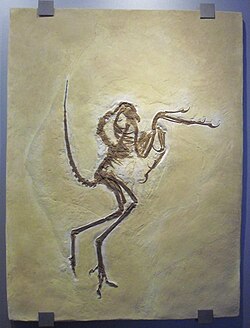 |
| Wyleyia [207] | Harrison & Walker | 1973 | Valid | Early Cretaceous | England | ||
| Xiangornis [208] | Hu et al. | 2012 | Valid | Early Cretaceous | China | ||
| Xinghaiornis [209] | Wang et al. | 2013 | Valid | Early Cretaceous | China | ||
| Xiaotingia [210] | Xu et al. | 2011 | Valid | Late Jurassic | China | Considered a non-avialan theropod by some researchers. |  |
| Yandangornis [211] | Cai & Zhao | 1999 | Valid | Late Cretaceous | China |  | |
| Yangavis [212] | Wang et al. | 2018 | Valid | Early Cretaceous | China | ||
| Yanornis [213] | Zhou & Zhang | 2001 | Valid | Early Cretaceous | China | 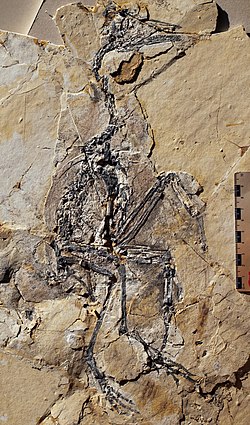 | |
| Yatenavis [214] | Herrera et al. | 2022 | Valid | Late Cretaceous | Argentina | ||
| Yi [215] | Xu et al. | 2015 | Valid | Late Jurassic | China | Considered a non-avialan theropod by some researchers. |  |
| Yixianornis | Zhou & Zhang | 2001 | Valid | Early Cretaceous | China |  | |
| Yixianosaurus [216] | Xu & Wang | 2003 | Valid | Early Cretaceous | China | Considered a non-avialan theropod by some researchers. |  |
| Yuanchuavis [217] | Wang et al. | 2021 | Valid | Early Cretaceous | China |  | |
| Yuanjiawaornis [218] | Hu et al. | 2015 | Valid | Early Cretaceous | China | ||
| Yumenornis [41] | Wang et al. | 2013 | Valid | Early Cretaceous | China |  | |
| Yungavolucris [219] | Chiappe | 1993 | Valid | Late Cretaceous | Argentina |  | |
| Yuornis [220] | Xu et al. | 2021 | Valid | Late Cretaceous | China | ||
| Zhongjianornis [221] | Zhou et al. | 2010 | Valid | Early Cretaceous | China | ||
| Zhongornis [222] | Gao et al. | 2008 | Valid | Early Cretaceous | China | ||
| Zhouornis [223] | Zhang et al. | 2013 | Valid | Early Cretaceous | China | 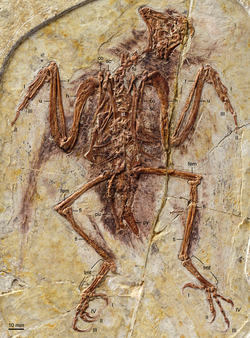 | |
| Zhylgaia [224] | Nessov | 1988 | Valid | Late Cretaceous | Kazakhstan | Dating is uncertain; may be Late Cretaceous or Paleogene. | |
| Zhyraornis [112] | Nessov | 1984 | Valid | Late Cretaceous | Uzbekistan |